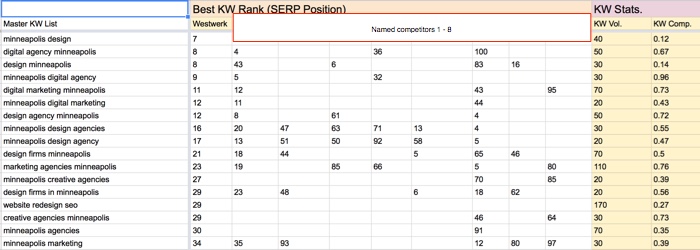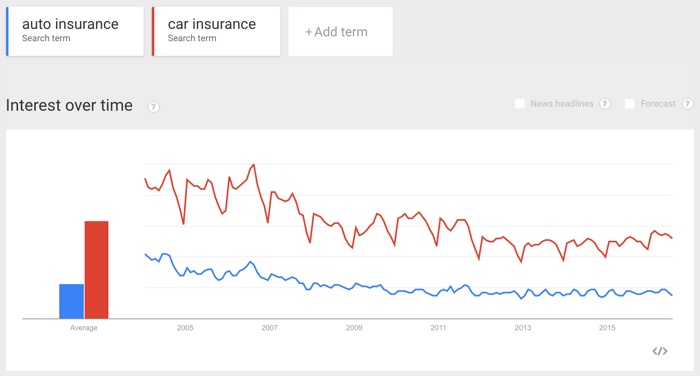
Information Architecture and Website Redesign SEO Keyword Research
In a recent blog post, I talked about how information architecture is a key consideration when planning a new website. Now let’s dig a little deeper into the analysis we perform during the information architecture strategy phase of the planning and design process.
The critical research and analysis components include:
- Keyword Research
- Content Audits & Functional Sitemaps
- Card Sorting
- User Profiles & Personas
Keyword Research & Analysis – How it Works
Today I’d like to discuss keyword research in more detail. I’ll begin by drawing a helpful distinction.
Keyword Research for Content Marketing
…is done for the purposes of content marketing campaigns to identify specific topics and questions around basic awareness, then to generate and promote digital collateral that addresses the questions people are typing into search engines.
The user intent we’re targeting in content marketing is information-seeking queries. The collateral (blog post, e-book, infographic, etc.) addresses a prospect’s needs and questions at the top of the decision funnel.

Keyword Research for Website Architecture
…is done to build the necessary overall digital footprint for your website based on your services or products. This helps ensure that you can be found by prospects at the research & comparison stage of the funnel.
We want to know:
- How are your online industry competitors positioned and who is enjoying SERP success? What are they doing well and what can we do better?
- What’s your digital footprint within your industry? Does this accurately reflect what you do?
- What specific service and content categories should have their own dedicated pages and be emphasized in the main navigation?
We gather and reverse engineer competitor keyword data to understand how effectively you are positioned within your industry. If you don’t already have a website, then we still gather the intel. on your competition and use that to identify opportunities!
The alternative to the systematic and analytical process outlined below is to simply take our best guess about what content should be on the site and what should be represented in the navigation.
Website Architecture Keyword Research Case Study – Westwerk
When Westwerk recently took a deeper look into our own website, SEO keyword research yielded some very useful insights…
The image below shows part of a working document with a master keyword list in the left column. The master list is generated from a keyword pull of Westwerk and our competitors’ ranking search terms, and aggregated using some spreadsheet formula magic.
Across the next 9 columns (in white) we see the number corresponding to the best ranking position that competitor achieved in SERP for that keyword. E.g., Westwerk ranked “7” for the term “minneapolis design.”

We learned that within our industry, our competitors were positioning themselves as either advertising agencies, development shops, visual design agencies, or digital agencies.
Once we understood how our competitors were digitally positioned, we narrowed our focus to other digital agencies.
Currently, 65.2% of Westwerk’s organic SERP footprint is comprised of the following categories:
- agency
- website design
- marketing
- advertising
Do these categories accurately represent what we do as a digital agency? Yes – very broadly.
Do they effectively position us for mid-funnel visibility in search engine results when a potential client is ready to find an agency to execute their website redesign, strategy or development? No!
Instead, we should be building our website content around these categories:
- website design (nailed it!)
- website development – emphasis on WordPress
- digital marketing strategy – emphasis on SEO, UI/UX and information architecture
- branding/rebranding
We can also identify specific page-level optimization opportunities:
We see that 7 agency websites ranked in the top 100 for the keyword “minneapolis design agencies.” This term is pretty popular among agencies, but not as popular with users (only 30 searches per month according to the “KW Vol.” column).
Conversely, Westwerk is the only site ranking for “website redesign SEO” and that specific keyword has a volume of 170 searches per month. Not bad since we’re not actively targeting it and at the time of this writing, we don’t have a dedicated evergreen service page discussing SEO and website redesigns.
In fact, I have gone back and worked instances of the phrase “website redesign SEO” into a few places in this post.
How Keyword Research Informs IA Strategy
The keyword research informs which pages are created and included on the functional sitemap and by extension, what options are in the main navigation.
Once we have necessary page topics identified we can further suss out related and synonymous keywords. The strategic advantage here is to:
- Map keywords to individual pages so we don’t compete with ourselves in SERP results.
- Ensure we’re using our target audience’s language.
Insurance agents may refer to insurance for your minivan as “auto insurance” while the consumers they want to reach more commonly refer to it as “car insurance.”
The Google Trends graph below confirms that an insurance agent should focus primarily on the term “car insurance” as she generates the copy for her website.

There may also be regional differences relating to language depending on your industry.
Once we have identified the topic and specific keywords to be used on the pages, we are able to write meta titles and descriptions, and write and optimize the copy on those pages.
Finally, in conjunction with card sorting exercises and an understanding of our user audiences, we can make informed decisions about what topics go into the main navigation of the site.
And there you have it – the basic process of competitor and SEO keyword research and how it helps inform the basic structure of your website during your website redesign. For more on information architecture, stay tuned for our upcoming blog post – Information Architecture and Content Audits.
